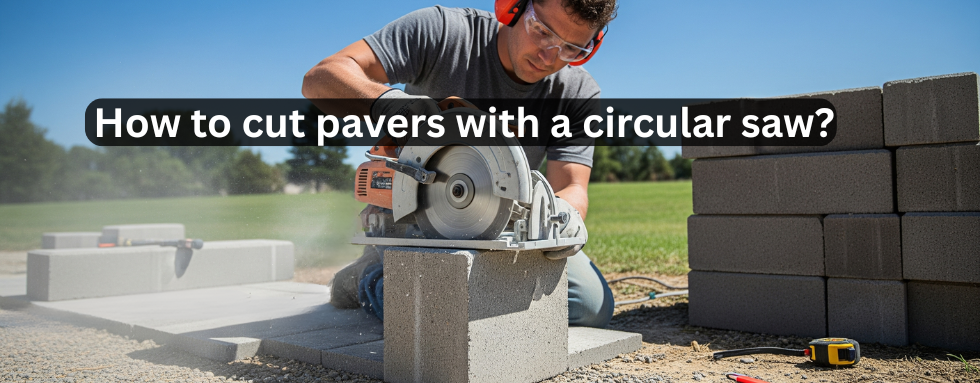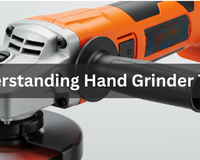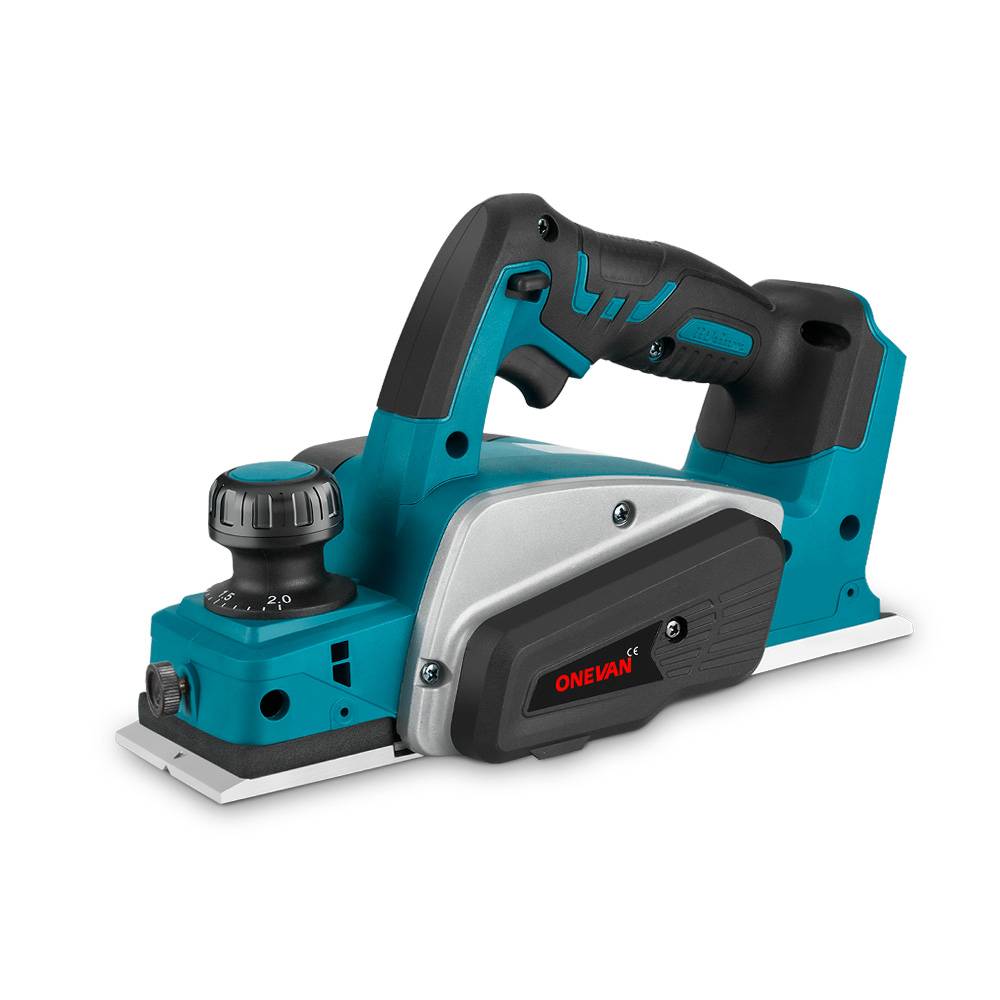Building a walkway, patio, and driveway with pavers is now common in villages and cities. Every mason and every house owner who wants a neat garden path asks the same question: how to cut pavers with a circular saw? Many people think cutting stone and concrete needs a big, expensive machine, but the truth is different. Can you cut concrete pavers with a circular saw? The answer is yes. Can you cut pavers with a circular saw? Also, yes, if you know the proper way.
In my twenty years working with stone and concrete, I have seen many changes. In the old days, we broke pavers with a hammer and chisel—it was very slow, there was much waste, and our hands ached after a few hours. Some people tried a hand saw, but it took a whole day for a small job. Now, with the right blade and technique, a circular saw cuts pavers as clean and quickly as cutting a wooden board.
1. Why Use a Circular Saw to Cut Pavers
Many people wonder if a circular saw can be used to cut pavers instead of other tools. Let me tell you why a circular saw is the best choice for most paver cutting jobs.
Extensive Selection of Circular Saw Blades
The biggest advantage is that many blade types are available. How to cut concrete pavers with a circular saw depends heavily on the blade choice. A diamond blade is for hard concrete, an abrasive wheel is for soft brick, a segmented blade is for fast cutting, and a continuous rim is for a smooth finish—every job has a perfect blade. A dry cutting blade is for when no water is available, a wet cutting blade is for reducing dust, and a turbo blade is for fast cutting. One can handle any paver material with the right blade collection. It is much cheaper than buying a separate machine for each stone type.
High Precision and Control
For a curved walkway, I mark a pattern on several pavers together and clamp a straight edge as a guide. The result is a smooth curve that fits perfectly. Customers are always surprised by how neat the joint lines look. Blade depth adjustment also helps with different thickness pavers. A thin patio stone requires a shallow cut, whereas a thick driveway paver needs a full-depth cut. The same circular saw handles both with a simple adjustment.
Superior Cutting Efficiency
The time comparison is clear: breaking twenty pavers by hand takes half a day, but a circular saw finishes the same job in one hour. You can cut fifty concrete pavers with a circular saw in the morning, and we can lay them all in the afternoon. A project finishes in one day instead of one week. Speed also means lower costs if you pay workers by the hour. A customer is happy with quick work, and a worker is satisfied with less fatigue. It is a win-win situation for everyone. The ONEVAN 180mm 7 Inch Brushless Cordless Circular Saw can cut through a thick concrete paver in thirty seconds—much faster than any hand method.
Portable and Easy to Use
A large wet saw machine requires a truck for transportation, a water connection, and a stable table. A circular saw can be carried in one hand and works anywhere. You can use it on a roof for repair, in a basement for an indoor project, or out in a field for a garden path—the saw goes wherever the work is needed. A battery-powered circular saw is especially good for a remote location. There is no extension cord or generator noise. Simply charge the battery the night before, and you can work all day without a problem. The lightweight design means less fatigue during a long cutting session.
2. Types of Paver
Different paver materials require different cutting approaches. Understanding the material helps you choose the right blade, the right technique, and the right safety measures.
Concrete Pavers
Features and Advantages
This is the most common paver type in my area. Concrete pavers are made from cement, sand, and aggregate—they are very hard but cut cleanly with a proper blade. Concrete pavers are available in many colors, shapes, and thicknesses. The uniform density means a consistent cutting result. The price is reasonable for most projects.
Recommended Blade
A diamond blade with a segmented rim works best. Use a dry cutting diamond blade if there is no water supply. A wet cutting blade is for those who want less dust. A turbo rim blade is designed for faster cutting, but it has a slightly rougher edge. Avoid an abrasive wheel—they wear too fast on hard concrete.
Brick Pavers
Features and Advantages
A traditional clay brick paver is softer than concrete, easier to cut, but more likely to chip. They have a beautiful red color, natural texture, and a classic look for an old-style garden. They cut cleanly, but require a gentle touch to prevent breaking. Brick pavers absorb water, so they work better in an area with good drainage. The natural material means slight color variation—it gives a rustic, handmade appearance.
Recommended Blade
An abrasive cutting wheel or a diamond blade both work. For a clean edge, a diamond blade is better. For rough work, an abrasive wheel is cheaper. Cutting brick pavers with a circular saw is more about applying gentle pressure than choosing the right blade.
Natural Stone Pavers
Features and Advantages
Granite, slate, and sandstone—each has a different hardness and grain pattern. They are the most expensive but the most beautiful. Each piece has a unique color and texture. They are very hard-wearing and last for generations with proper installation.
Natural stone can split along grain lines, so the cutting technique is important. Some stones are very hard, and some are soft and crumbly. You need to test each batch before cutting for the whole job.
Recommended Blade
A diamond blade is the only choice for hard stone like granite. A segmented rim is for rough cutting, and a continuous rim is for a smooth finish. Wet cutting is highly recommended to prevent overheating and to extend blade life.
Porcelain Pavers
Features and Advantages
This is a new material that is very hard and dense. It has a uniform color and texture and precise dimensions. It is resistant to stains, fading, and weather damage. It is popular for its modern design and clean appearance. It cuts very cleanly but is hard on a blade.
Porcelain pavers are often larger and thinner than concrete pavers. They need careful support during cutting to prevent breaking.
Recommended Blade:
Only a high-quality diamond blade works well. Use a continuous rim for the smoothest cut. Wet cutting is essential because porcelain generates a significant amount of heat during the cutting process. The blade wears fast, so keep a spare ready.
Rubber Pavers
Features and Advantages
These are made from recycled tire rubber and are soft and flexible. They are good for a playground, exercise area, or anywhere you need a cushioned surface. They cut easily, with no dust and quiet cutting. They are lighter-weight than stone pavers. Rubber pavers come in many colors, and interlocking designs are available. They provide good drainage and a non-slip surface. It is easy to replace a single paver if it gets damaged.
Recommended Blade
For rubber pavers, an abrasive blade or a blade specifically designed for cutting rubber is often recommended to achieve the best results. A sharp blade is important to prevent tearing the rubber.
3. Understanding the Tools and Materials When Cutting Pavers with a Circular Saw
Tools Needed for Cutting Pavers
Circular Saw
A corded circular saw typically offers more power for heavy work, while a cordless circular saw provides greater portability, but modern cordless circular saws with strong motors can also handle substantial tasks. A minimum 13-amp motor is needed for hard pavers. The ONEVAN 180mm Brushless Cordless Circular Saw with a strong motor handles all paver types without a struggle.
Diamond Blade
This is the most important tool after the circular saw itself. Match the blade to the material type. Keep a spare blade ready—cutting pavers wears a blade faster than wood.
Safety Equipment
Safety glasses are absolutely necessary—stone chips fly everywhere. A properly fitted N95 respirator or a dust mask is essential for health. Heavy work gloves protect hands from sharp edges. Hearing protection is for an extended cutting session.
Measuring Tools
A good measuring tape, a square for marking right angles, a chalk line for long straight cuts, and a marker that shows clearly on a stone surface.
Support Equipment
Sawhorses or a cutting table for support. Clamps to hold the paver securely. A straight edge for a guide when cutting. A level to check paver placement.
Water Spray Bottle
This is for dust control with dry cutting. A garden hose is used for wet cutting setups. An old towel is for wiping wet pavers.
Materials Required
Pavers
Order 10% extra for waste and future repairs. Check each batch for consistent thickness and quality before cutting.
Sand
This is for a levelling bed under the pavers. It is also useful for supporting pavers during cutting.
Plastic Sheeting
To catch stone dust and chips during cutting. This makes cleanup easier and protects the surrounding area.
Marking Supplies
A bright marker, chalk, or a pencil that writes on stone. Masking tape is for temporary marking.

4. Step-by-Step Guide on Cutting Pavers with a Circular Saw
Step 1: Safety Precautions
The first thing is always to use safety equipment before you touching any tool. Safety glasses must cover your eyes completely, not just the front. Stone chips can bounce from every direction. An N95 or higher-rated respirator is recommended to ensure adequate protection against fine dust particles generated during cutting, and filters should be changed regularly to maintain effectiveness.
Work gloves need a good grip but not be too thick that you lose tool control. Leather palm gloves work well for stone work. Check gloves for holes—stone dust can get through a small opening and irritate the skin. Clear the work area of loose objects. Stone chips can hit and break glass or scratch car paint. Warn family and neighbours about the noise and dust. Cover plants and outdoor furniture with a plastic sheet.
Check an extension cord for damage if you are using a corded circular saw. Wet conditions and power tools are a dangerous combination. Keep the cord away from the cutting area. A ground fault circuit interrupter outlet is recommended for safety.
Advanced tip
Set up a work area with good lighting from multiple angles. Shadows can hide a cutting line, potentially causing a mistake. Position your work so your dominant hand has a clear cutting path without awkward reaching.
Step 2: Measuring and Marking Pavers
Measure twice, cut once—this old saying is very true for an expensive paver. Use a sharp marker that shows clearly on the paver surface. Use a white marker on a dark paver and a dark marker on a light paver.
For straight cuts, use a straight edge and draw a complete line across the paver. For angled cuts, use a square or protractor for an accurate angle: Mark both the top and side if the paver is thick.
When cutting multiple pavers the same size, make a template from scrap wood or cardboard. This speeds up marking and ensures all pieces are identical. Number each piece if it is part of a pattern design.
Advanced tip
For complex cuts or curves, make a paper template first. Test fit the template in the actual location before marking the paver. It is much cheaper to remake a paper template than to waste an expensive paver.
Step 3: Setting Up the Circular Saw
Install the correct blade for the paver material. A diamond blade is for concrete and stone, an abrasive wheel is for brick, and A fine-tooth blade is often recommended for cutting rubber. Check that the blade direction arrow matches the circular saw rotation direction.
Set the blade depth to cut just through the paver thickness. Setting the blade depth to exceed the paver thickness can create more dust, noise, and wear the blade faster.For thick pavers, you may need two passes—a first pass with partial depth and a second pass to complete the cut.
Check that the blade guard works properly. The guard should snap back to cover the blade when you are not cutting. Clean any sawdust or debris that blocks the guard's movement.
Test the circular saw on a scrap piece before cutting good pavers. Check that the blade is sharp, the motor runs smoothly, and the cutting action is proper. Adjust the speed if the circular saw has variable speed control—slower for hard materials.
Advanced tip
Mark the desired cutting speed on the circular saw housing with a permanent marker. This helps you remember the correct setting for each material type. ONEVAN 125mm Brushless Cordless Circular Saw with speed control makes this adjustment easy.
Step 4: Positioning the Paver
Support the paver on both sides of the cut line. Use sawhorses, a cutting table, or a stable surface. An unsupported paver can break during cutting, which wastes material and can possibly cause an injury. Clamp the paver if possible, especially for precision cuts. The paver can shift during cutting and ruin a straight line. Use padded clamps to avoid marking the paver surface. Position the paver so the cut line hangs over the support edge. This way, the cut piece falls free without binding the blade. Have someone help hold the large pavers steady during cutting.
For a wet cutting setup, position a garden hose to spray the blade area. Water reduces dust and keeps the blade cool. But it also makes the cutting area slippery, so work carefully and wear non-slip shoes.
Advanced tip
Place a sacrificial board under the cut line to protect the circular saw table. Stone chips can damage a good cutting surface. A cheap plywood board saves an expensive table top.
Step 5: Making the Cut
Start the circular saw before the blade touches the paver. Let the blade reach full speed for smooth cutting. Lower the blade to the paver surface gently—sudden contact can chip the paver edge. Push the circular saw forward with steady, moderate pressure. Too fast pressure can overheat the blade or cause a rough cut. Operating too slowly can cause the blade to wander or burn. Keep the circular saw moving through the entire cut. Stopping in the middle of a cut can cause a blade mark or blade binding. If you must stop, pull the blade back slightly before stopping the motor. Support both pieces near the end of the cut so they do not fall and break. Cut completely through the paver, then turn off the circular saw before lifting the blade away.
Advanced tip
For deep pavers, make a partial cut from one side, then flip the paver and complete the cut from the other side. This technique gives a cleaner edge and reduces the chance of chipping.
Step 6: Achieving Clean Cuts
A clean edge is important for a professional appearance. A diamond blade gives the cleanest cut, but technique also matters. A steady speed, a sharp blade, and proper support all contribute to a clean edge. After cutting, check the edge for chips or rough spots. Small chips can be smoothed with a grinding stone or coarse sandpaper. Large chips may require cutting a new paver.
Test fit the cut paver in the final location before cutting additional pieces. A small adjustment is easier to make than to recut an entire paver. For visible edges, consider a slight bevel with an angle grinder. A small bevel hides minor imperfections and gives a finished appearance.
Advanced tip
Save all cut pieces, even small ones. They are often useful for filling corners or making repair patches later in a project.
5. Common Problems When Cutting Pavers with a Circular Saw
|
1. Incorrect Blade Choice
Problem: Using a wood blade on concrete creates excessive sparks, burns the blade, and gives a rough cut. |
|
2. Inadequate Safety Measures
Problem: Stone chips cause eye injury, dust creates breathing problems, and noise damages hearing. |
|
3. Inconsistent Cutting Depth
Problem: Blade depth change during cutting creates uneven cuts and possible blade binding. |
|
4. Dust Generation and Visibility Issues
Problem: Stone dust clouds hide cutting lines, create health hazards, and cover everything nearby. |
|
5. Inadequate Surface Support
Problem: Unsupported pavers break during cutting, creating a safety hazard and waste material. |
|
6. Blade Overheating
Problem: Blade turns blue from heat, cuts poorly, and wears out quickly. |
|
7. Rough or Chipped Edges
Problem: Poor edge quality requires extra finishing work and looks unprofessional. |
|
8. Tool Vibration and Control Issues
Problem: Excessive vibration makes accurate cutting difficult, causes fatigue, and may result in loss of control. |
6. Troubleshooting When Cutting Pavers with a Circular Saw
|
1. Blade Binding or Jamming
Issue: The blade gets stuck in the cut, the motor stalls, and there is a possible kickback danger. |
|
2. Excessive Dust Production
Issue: Dust clouds hide work, create health hazards, and cover areas with fine powder. |
|
3. Inaccurate Cuts
Issue: Cut line is not straight, angles are not square, and pieces do not fit properly. |
|
4. Blade Overheating
Issue: Blade turns color from heat, cut slowly, and possible blade damage. |
|
5. Rough or Chipped Edges
Issue: Cut edges are rough and chipped, requiring extensive finishing work. |
|
6. Vibration and Loss of Control
Issue: The Saw vibrates excessively, is difficult to control, and tiring to use. |
|
7. Premature Blade Wear
Issue: The blade dulls quickly, necessitating frequent replacement, which in turn increases project costs. |
7. Conclusion
Cutting pavers with a circular saw lets you create amazing outdoor projects. Use the right blade and technique for professional results. Practice on scrap pieces first. Try dry, wet, and guided cuts. Soon, you will be cutting pavers like a pro. The important thing is to keep different blades for different materials. Save leftover pieces for practice and future repairs.
8. FAQs
Can I use a regular blade to cut pavers with a circular saw?
No, regular wood blades do not work for stone pavers. A diamond blade is necessary for concrete and natural stone. Abrasive cutting wheel works for brick. Using the wrong blade is dangerous and gives poor results.
How can I prevent dust when cutting pavers?
Use the wet cutting technique with a water spray on the blade. Work in an open area with good ventilation. Wear a proper dust mask always. Consider a dust collection system for indoor work.
What is the best type of circular saw for cutting pavers?
Corded circular saw with a minimum 13-amp motor for heavy paver work. Cordless circular saw was good for small jobs and portable work. Variable speed control is helpful for different materials. A strong motor is important for hard concrete pavers.
How do I ensure precise measurements for my cuts?
Use quality measuring tools, mark clearly with appropriate markers, and make a template for repeated cuts. Measure twice before cutting. Use a cutting guide for straight lines. Practice on scrap pieces first.
Are there alternative methods to cut pavers if I don't have a circular saw?
Yes—angle grinder with diamond blade for small cuts, wet saw for precision work, chisel and hammer for rough breaking. But circular saws give the best combination of speed, accuracy, and cost for most projects.
Can I cut pavers wet to reduce dust?
Yes, wet cutting greatly reduces dust and keeps blades cooler. Need a wet cutting diamond blade and a water source. Make the area slippery, so use extra safety precautions—the best method for health and blade life.









